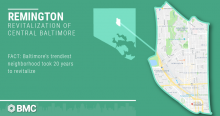FY2023 AI Implementation Plan
FY2023 AI Implementation Plan
Twenty years ago, Remington faced more than a decade of population decline (8.97 percent), 2.52 percent higher than Baltimore City at the time, which the region’s stakeholders assessed negatively affected the neighborhood’s stability. On Saturday, May 12, hundreds of people milled about through a two-block area - between the newly developed and trendy mixed spaces of Remington Row and R. House - to eat, drink and listen to live music on a hot spring day. It wasn’t an event exclusively for Johns Hopkins University students, nor a give-away at Charm City Cakes. RemFest 2018, Remington’s inaugural outdoor festival, was the announcement that this is a neighborhood on the rise.On Saturday, May 12, hundreds of people milled about through a two-block area - between the newly developed and trendy mixed spaces of Remington Row and R. House - to eat, drink and listen to live music on a hot spring day. It wasn’t an event exclusively for Johns Hopkins University students, nor a give-away at Charm City Cakes. RemFest 2018, Remington’s inaugural outdoor festival, was the announcement that this is a neighborhood on the rise. But Remington’s revitalization story is a success because of its various public-private partnerships throughout the last 20 years. Residents, businesses, universities, nonprofits and the state have worked together to provide grant funding and mutually beneficial business deals to bolster these efforts and serve as a model for the Baltimore region. We dug into the Regional Information Center’s archives to read Remington’s 1998 Community Mini-Profile, one of a series that highlighted statistics in specific areas of Baltimore City, to compare it to the neighborhood’s recent renaissance. The report, prepared by the Community Development Resource Center at the Institute for Urban Research at Morgan State University, examines seven key aspects of the Remington community: population, households and families, housing, health, education, income and public assistance, and crime. The intent of the report was to assess the needs of the Remington community, but also to use it as a marketing tool to assist in the revitalization of blighted parts of the neighborhood. So let’s rewind.The demographic breakdown of Remington in 1998 was 81 percent white and 13 percent black, with 25.37 percent of residents less than 19 years old, and 22.39 percent seniors. The teen pregnancy rate (10.20 percent) was 2 percent higher than Baltimore City’s, and cancer and heart attack/stroke were the main causes of death at 35 and 31.67 percent, respectively.These demographics suggested the need for day care services, education and recreation programming, as well as medical services and alternative living arrangements. It’s encouraging to see some of these assets realized, specifically through the 2017 completion of Remington Row, one of several Central Baltimore projects by Seawall Development, includes both physicians’ offices (for children, women’s health and internal medicine), a drug store and more than 100 affordable apartments. Speaking of housing, the Remington of 1998 included 1,199 units, with 91.49 percent total occupancy and 55.52 percent owner-occupied properties, according to the report.In 1997, the Johns Hopkins University’s Live Near Your Work employer-assisted home-buying program partnered with the state to offer cash grants between $2,500 and $17,000, according to Baltimore City’s 2012 Maryland Sustainable Communities application. The intent was to help employees buy homes in targeted areas around JHU’s Homewood and medical campuses, which many have done since then, therefore increasing owner-occupancy in the neighborhood and providing it with greater stability.Finally, Remington’s 1998 household income was $22,981, with utilization of public assistance services 26 percent below Baltimore City’s at the time. Today, organizations such as the Central Baltimore Partnership, Remington Neighborhood Alliance, Greater Remington Improvement Association, Charles Village Community Benefits District, Historic Fawcett Community Association and Healthy Neighborhoods work together to advocate on behalf of the community, organize and plan, then apply for grants to improve workforce development and transportation access for residents.Twenty years ago, Remington, a neighborhood of row houses and old factories, was on the decline. But the community has come together to create a place where people want to live, work, shop and raise families.Remington is both an example of the type of transformative revitalization that can be replicated across Baltimore as well as a reminder that real community change takes time, planning and partnership. Sources:Community Mini-Profile Series 1998 No. 02 (Spring Edition): Remington, prepared by the Community Development Resource Center, Institute for Urban Research, Morgan State University, Spring 1998

